Contact Us
- Room 2105, Xingda Garden, No. 122 Tianhua Middle Road, Xingsha Street, Changsha County, Hunan Province
- [email protected]
- +8617788962926
Flow pack machine, also known as a horizontal form-fill-seal (HFFS) machine, is an advanced packaging apparatus widely utilized in various industries for the efficient and automated packaging of a diverse range of products. This machine is particularly well-suited for items that require a flexible and tight wrapping, such as food products, pharmaceuticals, and non-food items. The distinctive feature of a Flow Pack Machine lies in its horizontal orientation during the packaging process.The operational principle of a Flow Pack Machine involves the continuous movement of a flat film or roll of packaging material through the machine, where it is formed into a tube. The product is then fed into this tube, and as the film advances, it is sealed both longitudinally and horizontally, creating a sealed package around the product. This seamless and tightly wrapped packaging not only provides an effective barrier against external factors like moisture and contaminants but also enhances the visual appeal of the final product on retail shelves.
Advantages of Flow Pack Machine
Versatility In Packaging
Flow pack machines are highly versatile and can accommodate a wide range of products, including various shapes and sizes. This flexibility makes them suitable for packaging items such as food products, pharmaceuticals, hardware, and more.
Seamless Integration With Automation
Flow pack machines can be seamlessly integrated into automated production lines, improving overall efficiency. Automated feeding systems, product conveyors, and packaging processes ensure a smooth and continuous flow of production, reducing manual labor and increasing output.
Enhanced Product Protection
The flow pack process involves creating a tight seal around the product, providing protection against external elements such as moisture, contaminants, and UV light. This helps extend the shelf life of the packaged items and ensures product integrity.
Increased Production Speed
Flow pack machines are designed for high-speed packaging, making them suitable for industries with high production demands. The continuous packaging process ensures a rapid and efficient workflow, contributing to increased overall productivity.
 Horizontal Flow Packing Machine
Horizontal Flow Packing MachineThe horizontal flow packing machine is an efficient automatic packaging machine. It is suitable for
Add to Inquiry Automatic Disposible Fork Knife Spoon Packing Machine Pac...
Automatic Disposible Fork Knife Spoon Packing Machine Pac...Disposable Plastic Wooden Spoon Fork And Knife Automatic Packaging Machine Cutlery Set With Napkin
Add to Inquiry Automatic Bread Packing Machine Packaging Machinery Horiz...
Automatic Bread Packing Machine Packaging Machinery Horiz...Easy Operate automatic bread sandwich packaging machine packing machine granola bar bread pan bread
Add to Inquiry Automatic Cake Packing Machine Packaging Machine Horizont...
Automatic Cake Packing Machine Packaging Machine Horizont...Automatic Biscuit chocolate cake products pillow bag automatic flow packing wrapping machine
Add to Inquiry Automatic Soap Packing Machine Packaging Machine Flow Wra...
Automatic Soap Packing Machine Packaging Machine Flow Wra...China high speed automatic small bar solid soap packaging machine small hotel home bath soap
Add to Inquiry Full Automatic Ice Cream Packaging Machine
Full Automatic Ice Cream Packaging MachineFull automatic ice cream packaging machine Application: This machine is suitable for pack of food,
Add to Inquiry Disposable Knife, Fork, Spoon Packaging Machine
Disposable Knife, Fork, Spoon Packaging MachineDisposable knife, fork, spoon packaging machine Application: This machine is suitable for pack of
Add to Inquiry Horizontal Flow Packing Machine
Horizontal Flow Packing MachineHorizontal packing machine Application: This machine is suitable for pack of food, biscuit, pie,
Add to Inquiry
Why Choose Us
High Quality
Our products are manufactured or executed to a very high standard, using the finest materials and manufacturing processes.
Professional Team
Our professional team collaborates and communicates effectively with each other, and is dedicated to delivering high quality results. We are capable of handling complex challenges and projects that require our specialized expertise and experience.
Advanced Equipment
A machine, tool or instrument designed with advanced technology and functionality to perform highly specific tasks with greater precision, efficiency and reliability.
24h Online Service
We try and respond to all concerns within 24 hours and our teams are always at your disposal in case of any emergencies.
How to Choose Flow Pack Machine
Product Characteristics
Evaluate the size, shape, and characteristics of the products you intend to pack. Consider factors such as product fragility, dimensions, and surface texture, as these aspects can influence the choice of film and sealing mechanisms.
Packaging Material Compatibility
Ensure that the Flow Pack Machine is compatible with the type of packaging material you plan to use. Consider the material's thickness, composition, and barrier properties to meet the specific needs of your products.
Production Volume
Determine your expected production volume and choose a machine with the appropriate speed and efficiency. Consider whether the machine can handle the required throughput without compromising the quality of packaging.
Flexibility And Adjustability
Opt for a Flow Pack Machine that offers flexibility in adapting to different product sizes, shapes, and configurations. Machines with adjustable settings and quick changeover capabilities enhance versatility in production.
Ease Of Operation
Choose a machine with user-friendly controls and interfaces. Intuitive operation and easy adjustments contribute to efficient workflow and reduce the likelihood of errors during setup and production.
Film Waste Reduction
Assess the machine's ability to minimize film waste. Features such as automatic film tracking, precise cutting mechanisms, and efficient film usage contribute to cost savings and environmental sustainability.
Sealing Technology
Consider the type of sealing technology employed by the machine, such as hot sealing or cold sealing. The choice depends on the characteristics of your products and the desired shelf life.
Quality Of Seal
Ensure that the machine provides a consistent and reliable seal to maintain the freshness and integrity of the packaged products. The quality of the seal is crucial for product safety and presentation.
Forming
The machine forms a continuous tube or pouch from a roll of flexible packaging material, usually made of materials like plastic films or laminates.
Product Feeding
Products to be packaged are fed into the formed packaging material. The feeding mechanism can vary depending on the type and size of the products, and it ensures a consistent and controlled flow of items into the packaging process.
Sealing
The flow pack machine seals the packaging material around the product using heat-sealing mechanisms. Common sealing methods include vertical and horizontal heat-sealing bars that create secure and airtight seals.
Cutting
The continuous tube of packaging material, now containing the product, is cut into individual packages. The cutting mechanism is often synchronized with the sealing process to ensure precise and clean cuts.
Wrapping and Overwrapping
The machine wraps the packaging material tightly around the product, creating a form-fitted package. Some flow pack machines may include additional overwrapping features to enhance product protection and aesthetics.
Film Registration and Centering
Advanced flow pack machines are equipped with systems that ensure accurate registration and centering of the packaging material, aligning it correctly with the product for consistent packaging.
Adjustable Packaging Parameters
Operators can typically adjust various parameters, such as packaging speed, bag length, and sealing temperature, to accommodate different product sizes and packaging requirements.
Versatility For Various Products
Flow pack machines are versatile and can handle a wide range of products, including food items (such as snacks, bakery goods, and fresh produce), medical devices, pharmaceuticals, electronics, and more.
Integration With Other Packaging Equipment
Flow pack machines can be integrated into complete packaging lines, working in conjunction with other equipment such as filling machines, labeling systems, and conveyors to streamline the entire packaging process.
High-speed Packaging
Many flow pack machines operate at high speeds, making them suitable for large-scale production environments where efficiency and speed are critical.
Enhanced Product Presentation
Flow pack packaging provides a visually appealing presentation for products, often enhancing their marketability and shelf appeal.
Extended Shelf Life
The airtight seals created by flow pack machines help extend the shelf life of products, particularly for items requiring protection from moisture, contaminants, or other environmental factors.
How Does a Flow Pack Machine Differ from Other Packaging Machines
Flow pack machine, also known as a horizontal form-fill-seal (HFFS) machine or a flow wrapper, has specific characteristics that distinguish it from other types of packaging machines. While various packaging machines share common goals of efficiently packaging products, the design and functionalities of each type cater to specific packaging needs. Here are key differences between a flow pack machine and other packaging machines:
Flow Pack Machine: The primary function of a flow pack machine is to form, fill, and seal a continuous tube or pouch of flexible packaging material around a product. It operates in a horizontal direction, producing tightly wrapped packages.
Other Packaging Machines: Different types of packaging machines, such as vertical form-fill-seal (VFFS) machines, focus on vertical packaging operations. These machines form, fill, and seal packages in a vertical direction.
Flow Pack Machine: The flow pack machine typically uses a flat, continuous roll of flexible packaging film to create a horizontal seal around the product.
Other Packaging Machines: Vertical form-fill-seal machines use a vertical configuration, where the packaging material is typically in the form of a continuous tube.
Flow Pack Machine: The product is horizontally oriented during the packaging process. This makes flow pack machines suitable for a wide range of flat or slightly irregular-shaped products.
Other Packaging Machines: Depending on the type, other packaging machines may be designed for vertical orientation, making them suitable for products with a different shape or packaging requirement.
Flow Pack Machine: Flow pack machines are known for their high-speed packaging capabilities, making them suitable for applications requiring rapid packaging on production lines.
Other Packaging Machines: The packaging speed of other machines may vary depending on the type and design. Some machines are optimized for high-speed operations, while others may operate at a slower pace.
Flow Pack Machine: Flow pack machines are versatile and commonly used for packaging a variety of products, including food items, medical devices, electronics, and consumer goods.
Other Packaging Machines: Different types of packaging machines cater to specific applications. For example, blister packaging machines are often used in pharmaceuticals, while vertical form-fill-seal machines are suitable for powders, granules, and liquids.
Flow Pack Machine: Flow pack packaging provides a tight, form-fitted appearance around the product, enhancing its visual appeal. It is often used for products with a focus on presentation.
Other Packaging Machines: The aesthetics of packaging can vary based on the design and type of packaging machine used. For example, blister packaging may provide a more rigid and protective appearance.
Flow Pack Machine: Flow pack machines can be integrated into complete packaging lines, working alongside other equipment such as conveyors, filling machines, and labeling systems.
Other Packaging Machines: Similar integration capabilities exist for other packaging machines, allowing them to be part of a comprehensive packaging solution.
What Types of Products Can Be Packaged Using a Flow Pack Machine
Flow pack machine, also known as a horizontal form-fill-seal (HFFS) machine or a flow wrapper, is a versatile packaging solution that can be used to package a wide variety of products. The adaptability of flow pack machines makes them suitable for packaging items in various industries. Here are some examples of products that can be packaged using a flow pack machine:

Food Products
Snack Foods: Flow pack machines are commonly used to package a wide range of snack foods, including chips, pretzels, cookies, and crackers.
Bakery Goods: Products like cookies, brownies, pastries, and bread rolls can be efficiently packaged using flow pack machines.
Fresh Produce: Fruits and vegetables, such as cucumbers, carrots, and apples, can be packaged using flow wrap to extend their shelf life.
Confectionery: Candies, chocolates, and other confectionery items can be neatly wrapped using flow pack packaging.
Dairy Products
Cheese: Flow pack machines can package various types of cheeses, including sliced or shredded cheese.
Butter and Margarine: Flow wrapping is suitable for packaging butter or margarine in individual portions or larger blocks.
Frozen Foods
Frozen Snacks: Flow pack machines can efficiently package frozen snacks like spring rolls, samosas, or mini pizzas.
Frozen Vegetables: Individual or multi-packaging of frozen vegetables is possible with flow pack machines.
Beverages
Single-Serve Drinks: Flow pack machines can be used for packaging single-serve beverage items, such as juice boxes or drink pouches.
Energy Bars: Flow wrapping is commonly used for packaging energy bars and protein bars.
Pharmaceuticals And Medical Devices
Pharmaceuticals: Flow pack machines can be employed for packaging pharmaceutical products, including tablets, capsules, and blister packs.
Medical Devices: Items like syringes, bandages, and sterile medical devices can be packaged using flow wrap.
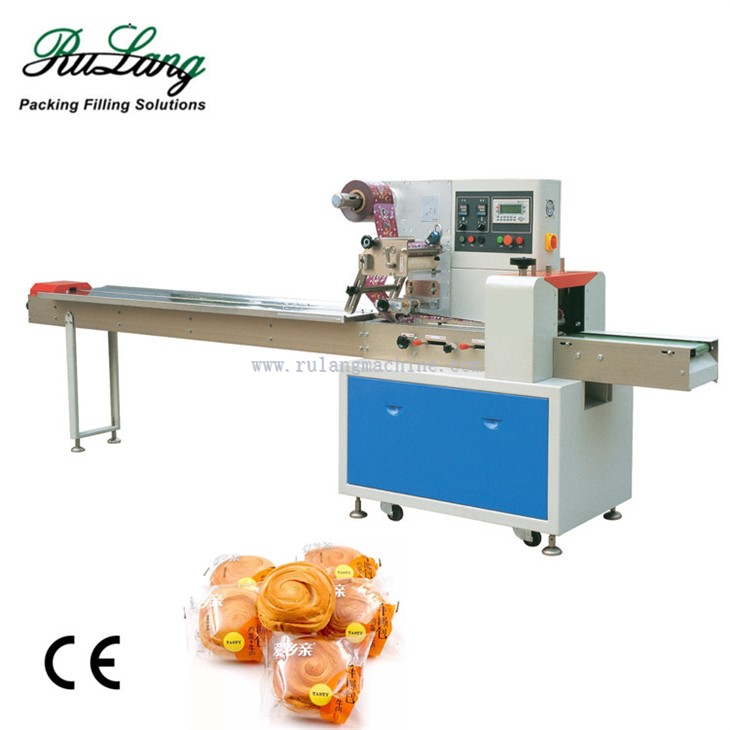
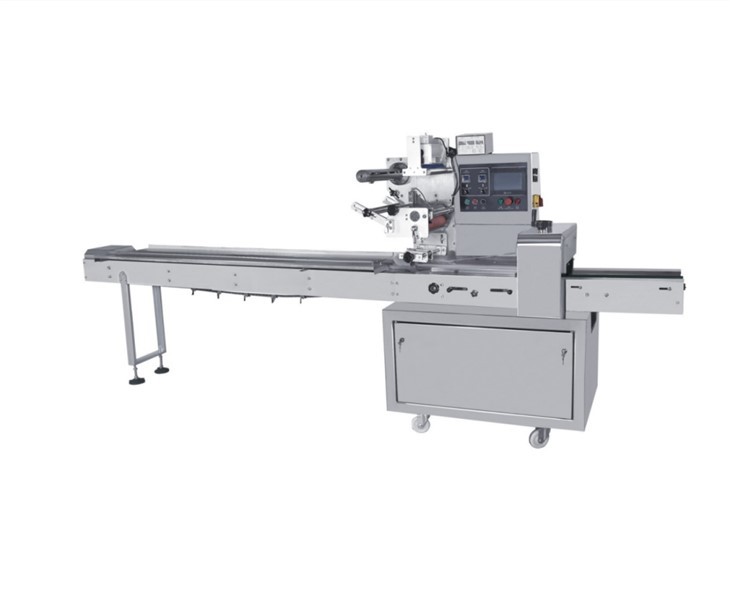
Personal Care And Cosmetics
Soaps and Bath Products: Flow pack machines can package individual or multi-pack units of soaps and bath products.
Cosmetic Products: Items like cosmetic wipes, face masks, and other beauty products can be efficiently flow-wrapped.
Household Products
Cleaning Wipes: Flow wrap is suitable for packaging individual or multi-packs of cleaning wipes.
Stationery Items: Products like pens, markers, and erasers can be packaged using flow pack machines.
Electronics
Cables and Accessories: Flow pack packaging can be used for neatly wrapping cables, chargers, and electronic accessories.
Small Gadgets: Electronics such as headphones, earbuds, or small gadgets can be packaged using flow wrap.
Textiles And Apparel
Socks and Underwear: Flow pack machines can be used to package individual or multi-packs of socks, underwear, and other textile items.
T-shirts and Apparel: Garments like T-shirts and clothing accessories can be efficiently flow-wrapped.
Hardware And Tools
Small Tools: Flow wrap can be used for packaging small tools, fasteners, and hardware items in individual or multi-packs.
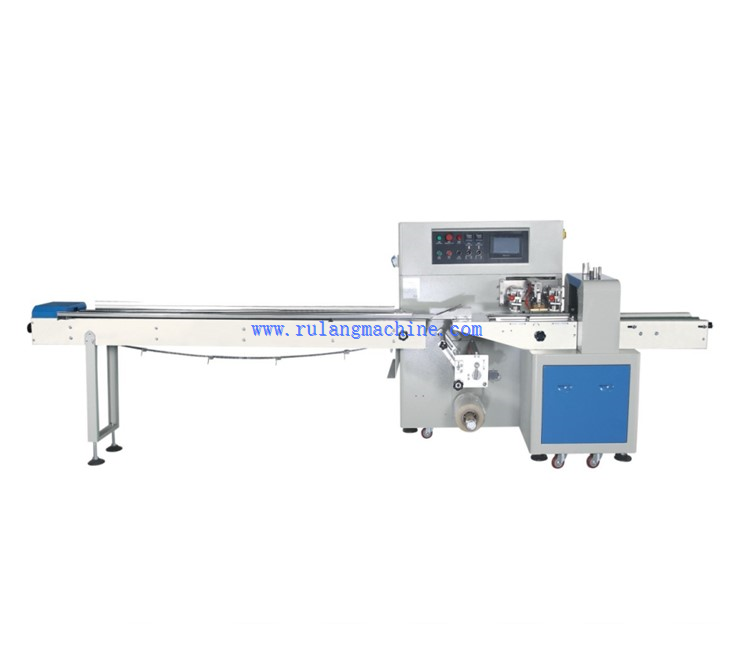
How Is the Film Fed into the Flow Pack Machine
The film feeding process in a flow pack machine is a crucial step in the packaging operation, as it determines how the packaging material is supplied and used to wrap the products. The film feeding mechanism is designed to handle a continuous roll of flexible packaging material, such as a flat film or a film in the form of a tube. The specific design may vary among different flow pack machines, but the general process involves the following steps:
Film Roll Loading
A new roll of packaging film is loaded onto the flow pack machine. The film roll is typically mounted on a spindle or shaft that facilitates easy unwinding.
Film Unwinding
The film unwinding mechanism is responsible for pulling the film off the roll. It ensures a continuous and controlled supply of packaging material for the packaging process.
Tension Control
Tension control systems are used to maintain the proper tension of the film as it is unwound. Proper tension is crucial to ensure smooth and consistent feeding of the film through the machine.
Film Straightening And Alignment
In some flow pack machines, the film may undergo straightening or alignment processes to ensure that it is positioned correctly before forming and sealing around the products. This step helps maintain the accuracy of the packaging process.
Film Forming
The film forming section shapes the packaging material into the desired configuration to create a pouch or tube that will encase the products during the packaging process.
Product Loading
Simultaneously or shortly after forming, the products to be packaged are introduced into the film. The product feeding mechanism ensures a consistent flow of items into the packaging material.
Sealing And Cutting
Once the products are loaded into the film, the flow pack machine proceeds to seal and cut the film to create individual packages. Sealing is usually achieved using heat-sealing bars, and the cutting mechanism separates the packages.
Discharge Conveyor
After sealing and cutting, the finished packages move along a discharge conveyor for further processing or packaging. This conveyor facilitates the smooth and controlled exit of the packaged products.
How Does a Flow Pack Machine Ensure a Tight Seal Around the Product
Flow pack machine ensures a tight seal around the product through a combination of precise heat-sealing mechanisms and careful control of the packaging process. The sealing process is a critical step that directly influences the quality and integrity of the final package. Here's how a flow pack machine achieves a tight seal around the product:
Film Heating
Before the sealing process begins, the flow pack machine heats specific portions of the packaging film using heat-sealing bars or rollers. The heating elements raise the temperature of the film in the designated sealing areas.
Impulse Sealing Or Continuous Sealing
Flow pack machines typically employ either impulse sealing or continuous sealing methods.
Impulse Sealing: In impulse sealing, the heat-sealing bars are activated in short bursts or pulses. The heat is applied quickly, creating a temporary increase in temperature to seal the film. This method is effective for a variety of film types.
Continuous Sealing: Continuous sealing involves a continuous application of heat as the film passes through the sealing station. This method is suitable for specific film materials that require a more extended period of heat exposure for proper sealing.
Pressure Application
Simultaneously with the heating process, pressure is applied to the heated film in the sealing area. The pressure ensures that the film adheres tightly to itself, creating a secure and uniform seal around the product.
Cooling And Solidification
After the sealing process, the sealed portion of the film moves through a cooling section or cooling bars. This helps the material solidify and maintain the integrity of the seal. Rapid cooling prevents the seal from sticking to adjacent packaging material or losing its shape.
Adjustable Temperature Control
Flow pack machines are equipped with temperature control systems that allow operators to adjust the temperature of the heat-sealing elements. This adjustment is crucial for accommodating different types of packaging films, each with its specific heat-sealing requirements.
Sealing Jaw Design
The design of the sealing jaws or bars is essential for achieving a tight seal. The shape and configuration of these elements contribute to the effectiveness of the sealing process. Some machines have serrated or patterned sealing jaws to enhance the seal's strength.
Film Compatibility
Flow pack machines are designed to work with various packaging films, including polyethylene, polypropylene, laminates, and other flexible materials. The machine's settings and heat-sealing parameters are adjusted based on the specific characteristics of the chosen film.
Seal Integrity Monitoring
Some advanced flow pack machines may include seal integrity monitoring systems. These systems check the quality of each seal and can detect irregularities, ensuring that only properly sealed packages move forward in the production process.
How Is the Speed of a Flow Pack Machine Adjusted
The speed of a flow pack machine, also known as the packaging speed or throughput rate, refers to the rate at which the machine processes and packages products. Adjusting the speed of a flow pack machine is crucial for optimizing the production process, meeting specific production requirements, and ensuring the machine operates efficiently. The speed adjustment is typically achieved through various controls and settings. Here's an overview of how the speed of a flow pack machine is adjusted:
Motor Control
Flow pack machines are equipped with motors that drive the various components involved in the packaging process, such as the conveyor system, film unwinding, sealing bars, and cutting mechanisms. The speed of these motors can be adjusted to control the overall speed of the machine.
Variable Frequency Drives (VFDs)
Many modern flow pack machines use variable frequency drives (VFDs) to control the speed of electric motors. VFDs allow operators to vary the frequency and voltage supplied to the motors, enabling precise speed adjustments.
Human Machine Interface (HMI)
Flow pack machines are often equipped with a human-machine interface (HMI) or a control panel that provides operators with a user-friendly interface for adjusting machine settings, including the packaging speed. Operators can input the desired speed through the HMI.
PLC Programming
Programmable logic controllers (PLCs) are used to control and coordinate the different functions of the flow pack machine. The speed control parameters can be programmed into the PLC, allowing for automation and easy adjustments.
Inverter Control
Inverters or frequency inverters are devices that can be used to adjust the speed of AC motors. By changing the frequency of the electrical supply to the motor, inverters provide a means to control the motor speed, thus adjusting the overall machine speed.
Feedback Systems
Some advanced flow pack machines incorporate feedback systems, such as encoders or sensors, to monitor and provide real-time feedback on the machine's performance. This feedback allows the machine to automatically adjust its speed to maintain consistency and accuracy.
Integration With Other Machines
In production lines where multiple machines are integrated, the speed of the flow pack machine may be synchronized with the speeds of upstream or downstream machines. This ensures a smooth and continuous flow of products through the entire production process.
Product Characteristics
The speed of the flow pack machine may also be influenced by the characteristics of the products being packaged. For example, smaller or lighter products may require a higher speed, while larger or heavier products may be processed at a slower speed.
What Safety Measures Are in Place on a Flow Pack Machine
Flow pack machines are equipped with various safety measures to protect operators, prevent accidents, and ensure the safe and efficient operation of the equipment. The specific safety features may vary depending on the model and manufacturer, but common safety measures on flow pack machines include:
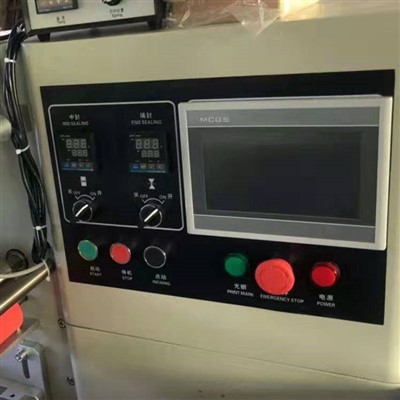
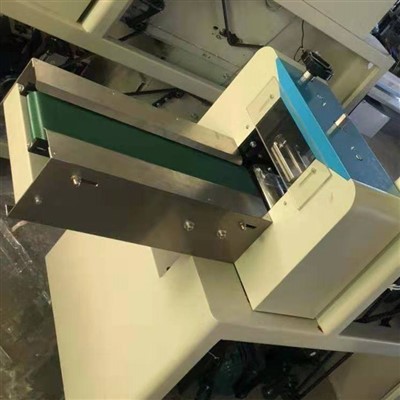
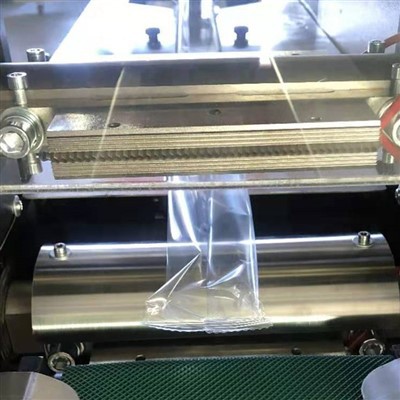

Emergency Stop Button
An easily accessible emergency stop button is typically installed on the machine. Pressing this button instantly halts the machine's operation in case of an emergency or when immediate intervention is required.
Safety Interlocks
Interlocks are used to ensure that certain components or access points of the flow pack machine are securely closed and in the proper position before the machine can operate. Opening doors or covers may trigger safety interlocks, preventing machine activation.
Safety Guards And Barriers
Physical barriers, guards, or shields are often installed around hazardous areas of the machine to prevent operators from coming into contact with moving parts, sealing bars, or cutting mechanisms during operation.
Light Curtains
In areas where operators need access to the machine, light curtains use infrared beams to detect the presence of hands or objects. If the beams are interrupted, the machine automatically stops to prevent injury.
Overload Protection
Flow pack machines may be equipped with sensors or systems to detect overloads or abnormal conditions. This helps prevent damage to the machine and reduces the risk of accidents caused by excessive loads.
Safety Labels And Signage
Clearly visible safety labels and signage are placed on the machine to indicate potential hazards, emergency stop locations, and operating instructions. Operators should be familiar with and follow these guidelines.
Warning Alarms And Indicators
Audible or visual alarms and indicators notify operators of any faults, malfunctions, or abnormal conditions on the machine. Prompt notification allows for quick intervention and troubleshooting.
Lockout/tagout (Loto) Procedures
Lockout/tagout systems are implemented to isolate and disconnect the flow pack machine from power sources during maintenance or servicing. This prevents accidental startups and ensures the safety of maintenance personnel.
Automatic Shutdown For Anomalies
The machine may be programmed to automatically shut down if it detects anomalies, such as irregular product flow, film misalignment, or deviations from specified parameters.
Limit Switches
Limit switches are used to define the operational boundaries of certain machine components, ensuring they do not exceed safe limits.
Emergency Procedures Documentation
Detailed documentation outlining emergency procedures, including steps to take in the event of a machine malfunction or injury, is typically provided and should be readily accessible to operators.
Regular Inspections And Maintenance
Routine inspections and maintenance are essential to ensure that safety features are functioning correctly. Any damaged or malfunctioning safety components should be addressed promptly.
What Is Involved in the Setup Process for a Flow Pack Machine
Machine Inspection
Conduct a visual inspection of the flow pack machine to ensure that all components are in good condition. Check for any signs of wear, damage, or loose parts. Make sure safety features, such as emergency stop buttons and safety guards, are functioning properly.
Select Packaging Material
Choose the appropriate packaging material for the specific products being packaged. The material may include flexible films, laminates, or other suitable materials. Ensure the material meets the requirements for the product's characteristics, shelf life, and presentation.
Film Roll Installation
Load a new roll of packaging film onto the machine's film unwinding system. Make sure the film is aligned properly, and the tension is adjusted to ensure smooth unwinding during the packaging process.
Adjust Film Guides
Adjust the film guides to ensure the packaging material is properly aligned and centered. Proper alignment prevents issues such as wrinkles, misalignments, or film distortions during the packaging process.
Set Film Registration
If the flow pack machine is equipped with a film registration system, set it up to ensure accurate positioning of the film. This is particularly important for achieving precise print registration or ensuring consistent placement of graphics on the packaging material.
Adjust Sealing Bars
Set the temperature and pressure parameters for the sealing bars based on the characteristics of the packaging material. The correct settings ensure strong and consistent seals. Adjust the sealing bars to accommodate the width of the film and the desired packaging format.
Product Feeding System
Configure the product feeding system based on the characteristics of the products being packaged. Adjust the conveyor speed, guides, and any other components to ensure a smooth and controlled flow of products into the packaging material.
Set Cutting Mechanism
Adjust the cutting mechanism to determine the desired package length. This ensures that the film is cut accurately, creating individual packages. Consider the size and dimensions of the products when setting the cutting parameters.
Adjust Speed And Timing
Set the machine's operational speed based on the desired packaging rate and the characteristics of the products. Ensure that the speed is synchronized with the feeding system, sealing bars, and cutting mechanism to maintain consistent and accurate packaging.
Calibration
Calibrate the flow pack machine to ensure accurate counting and positioning of products within the packaging material. Follow the manufacturer's guidelines for calibration procedures.
Test Runs
Perform test runs with sample products to verify that the machine is operating correctly. Check for any issues with sealing, cutting, or product positioning. Make adjustments as needed to achieve optimal results.
Quality Control Checks
Conduct quality control checks on the packaged products to ensure they meet the desired standards. Check for proper seals, accurate counts, and overall package appearance.
What Is the Role of Sensors in a Flow Pack Machine
Photoelectric Sensors
Role: Photoelectric sensors are used to detect the presence or absence of products as they move through the packaging process. These sensors can be positioned at different stages to ensure accurate product feeding, registration, and positioning within the packaging material.
Proximity Sensors
Role: Proximity sensors are employed to detect the presence or absence of objects, typically by using infrared or electromagnetic fields. They help ensure that components, such as sealing bars or cutting mechanisms, are properly positioned before the machine initiates specific actions.
Registration Mark Sensors
Role: Registration mark sensors are optical sensors designed to detect printed marks on the packaging material. These marks act as reference points, allowing the machine to synchronize the film's movement with the position of graphics or print on the packaging.
Temperature Sensors
Role: Temperature sensors are integrated into the sealing bars of the flow pack machine. These sensors monitor and regulate the temperature during the sealing process, ensuring that the correct heat is applied to achieve strong and consistent seals on the packaging material.
Pressure Sensors
Role: Pressure sensors are used to monitor the pressure applied by the sealing bars during the sealing process. This helps maintain the optimal pressure for creating secure seals without damaging the packaging material or the products.
Tension Sensors
Role: Tension sensors are employed to monitor the tension of the packaging material as it is unwound from the roll. Maintaining proper tension is crucial for preventing issues such as film wrinkles, misalignment, or distortions during the packaging process.
Encoder Sensors
Role: Encoder sensors provide feedback on the speed and position of various components, such as conveyor belts or film unwinding systems. This feedback allows the machine to synchronize the movement of different elements, ensuring accurate and consistent packaging.
Infrared Sensors
Role: Infrared sensors may be used to detect the presence of hands or foreign objects in areas where operators need access to the machine. These sensors can trigger safety features, such as emergency stop mechanisms, to prevent accidents.
Ultrasonic Sensors
Role: Ultrasonic sensors can be used to measure distances or detect the position of objects. In a flow pack machine, ultrasonic sensors may be employed to ensure proper spacing between products or to detect the end of a roll of packaging material.
Color Sensors
Role: Color sensors may be utilized to identify and verify the color of products or packaging material. This can be important for quality control and ensuring that the correct products are being packaged.
Counting Sensors
Role: Counting sensors are employed to accurately count the number of products as they move through the packaging process. This is essential for achieving the desired quantity of products in each package.
How to Maintain Flow Pack Machine
Cleaning And Lubrication
Keep the machine clean by removing dust, debris, and product residues. Regularly clean the sealing bars, cutting mechanisms, and other critical components. Lubricate moving parts according to the manufacturer's recommendations to minimize friction and wear.
Inspect Wear Parts
Regularly inspect and replace wear parts, such as sealing bars, cutting blades, belts, and conveyor components. Timely replacement helps prevent unexpected breakdowns and ensures the machine operates with precision.
Check Tension And Alignment
Ensure that the film tension is correctly adjusted to prevent issues like wrinkles or misalignments. Check the alignment of the film and other components to maintain the machine's accuracy.
Verify Sealing Temperature
Regularly check and calibrate the sealing temperature to ensure consistent and strong seals. Improper sealing temperatures can lead to packaging defects.
Inspect Sensors And Detection Systems
Check sensors, photoelectric cells, and detection systems regularly to ensure they are functioning correctly. Clean or replace sensors that may be obstructed by dirt or residue. Verify that the detection system accurately senses the presence and position of products.
Calibration
Calibrate the machine regularly to ensure accurate counting, positioning, and cutting. Follow the manufacturer's guidelines for calibration procedures.
Check Electrical Components
Inspect electrical components, including wiring, connectors, and control panels. Address any damaged or frayed wires, loose connections, or malfunctioning electrical components promptly.
Inspect Pneumatic Components
If the flow pack machine utilizes pneumatic components, check for air leaks and ensure that pneumatic cylinders and valves are functioning correctly.
Monitor And Adjust Conveyor System
Check the conveyor system for misalignments, wear, or damage. Adjust the conveyor speed and alignment as needed to ensure a smooth and controlled flow of products.
FAQ
Q: What is a Flow Pack Machine?
Q: How does a Flow Pack Machine work?
Q: What types of products are suitable for packaging with a Flow Pack Machine?
Q: What are the advantages of using a Flow Pack Machine?
Q: Can a Flow Pack Machine handle delicate or irregularly shaped products?
Q: What is the speed range of a typical Flow Pack Machine?
Q: Can a Flow Pack Machine provide airtight seals for perishable goods?
Q: How is the film waste minimized in a Flow Pack Machine?
Q: What is the role of the gas flushing system in a Flow Pack Machine?
Q: Is tooling changeover easy in a Flow Pack Machine?
Q: Can a Flow Pack Machine be integrated with other packaging equipment?
Q: Are there specific considerations for packaging heat-sensitive products with a Flow Pack Machine?
Q: How is the hygiene of a Flow Pack Machine maintained?
Q: Can a Flow Pack Machine handle packaging with printed film for branding?
Q: What training is required for operators to run a Flow Pack Machine?
Q: How are product jams handled in a Flow Pack Machine?
Q: Can a Flow Pack Machine handle packaging with multiple products in a single pack?
Q: What safety features are incorporated into Flow Pack Machines?
Q: Can a Flow Pack Machine handle packaging with variable product sizes?
Q: How is the film quality monitored during the packaging process?
We're professional flow pack machine manufacturers and suppliers in China, specialized in providing high quality products and service. We warmly welcome you to buy customized flow pack machine at low price from our factory. Contact us for quotation.
fully automatic namkeen packing machine, automatic polythene packing machine, automatic soap packing machine




